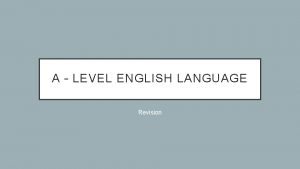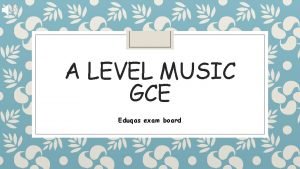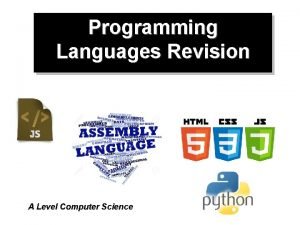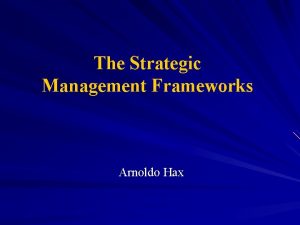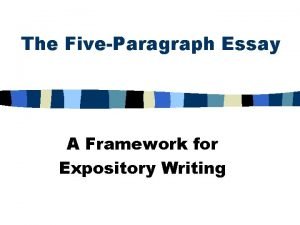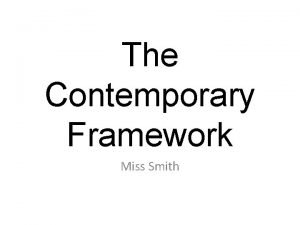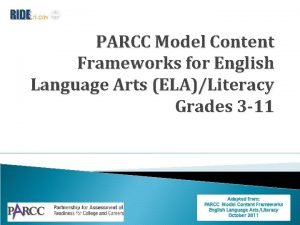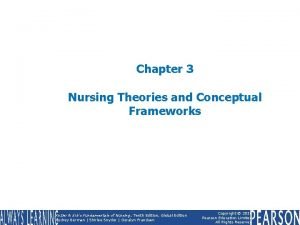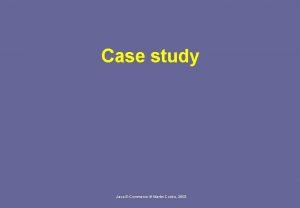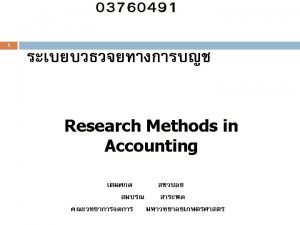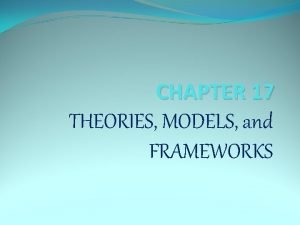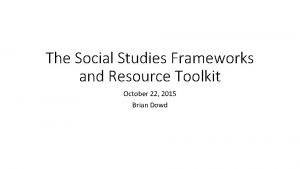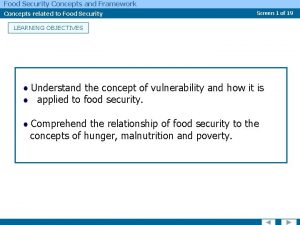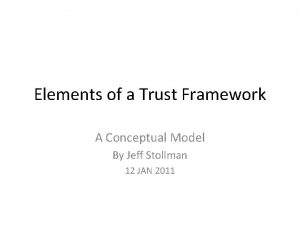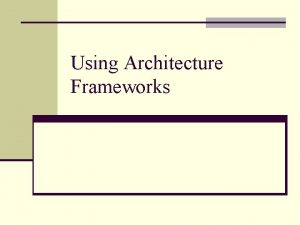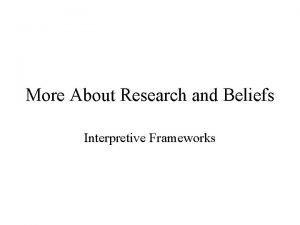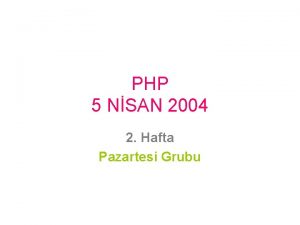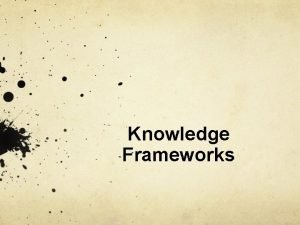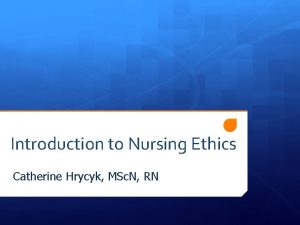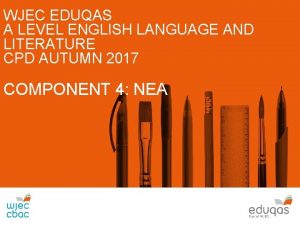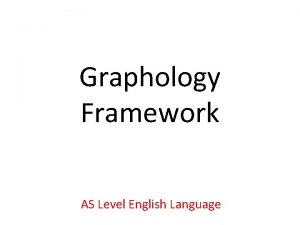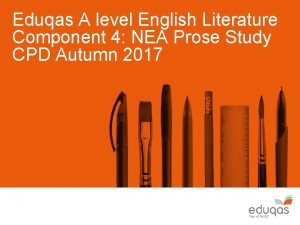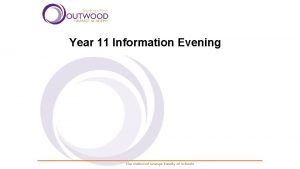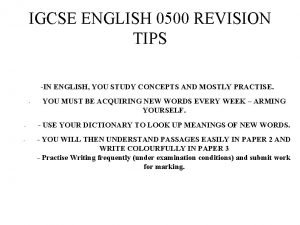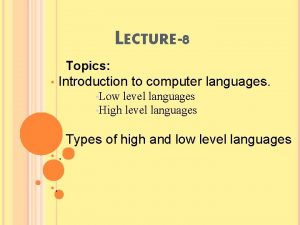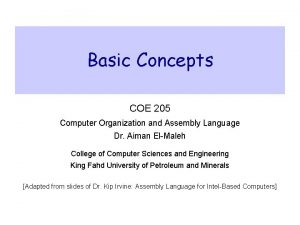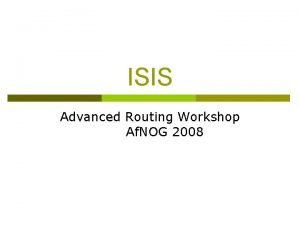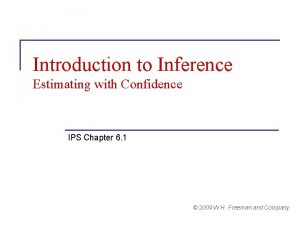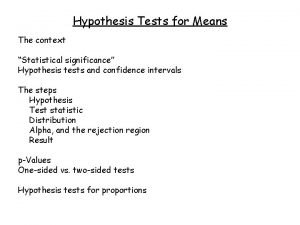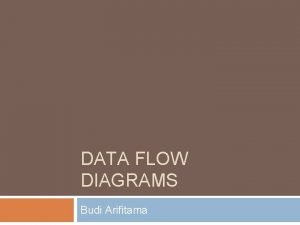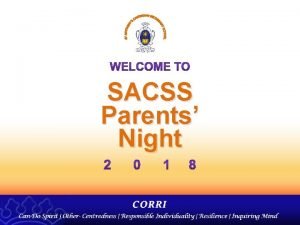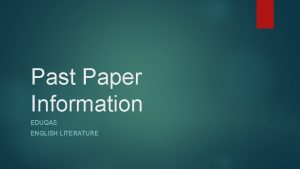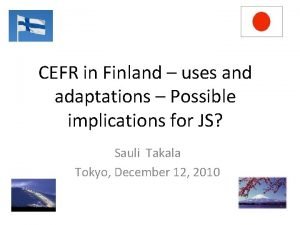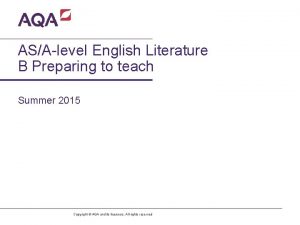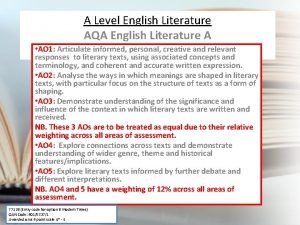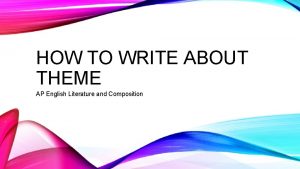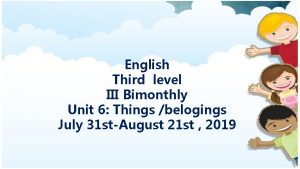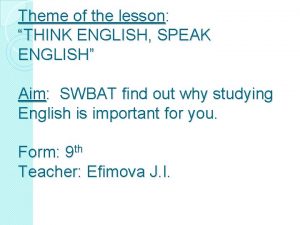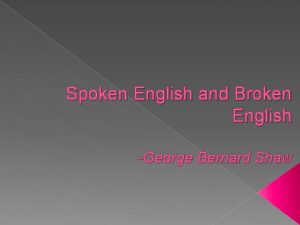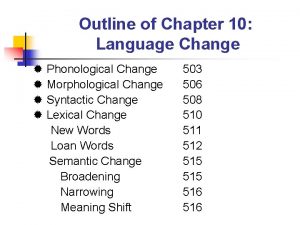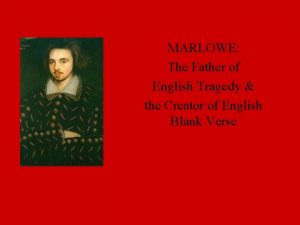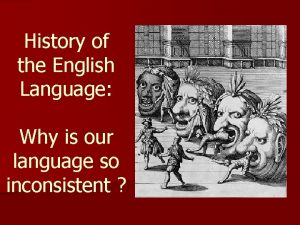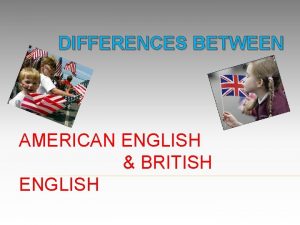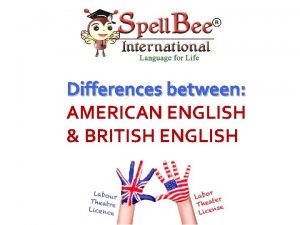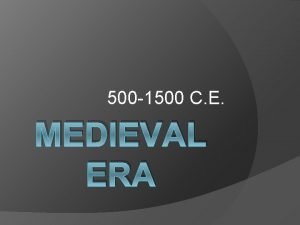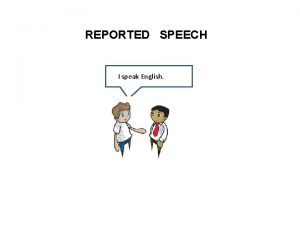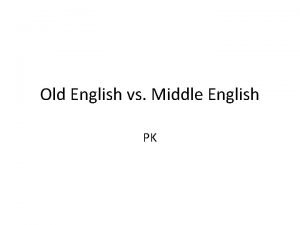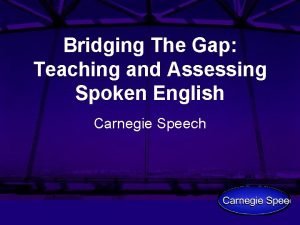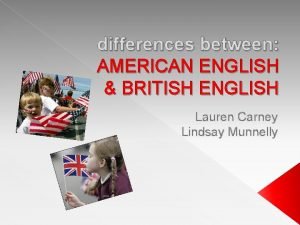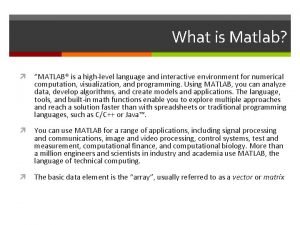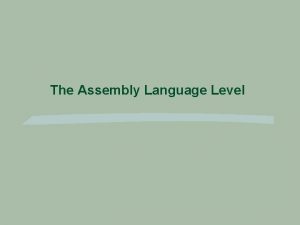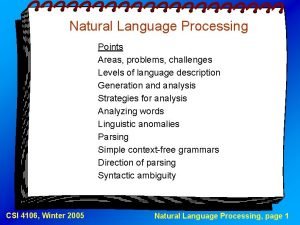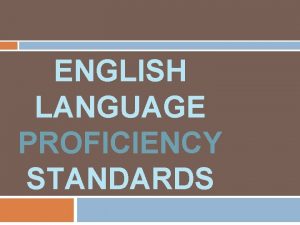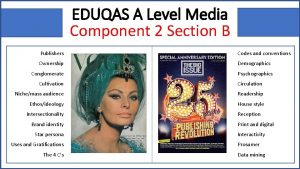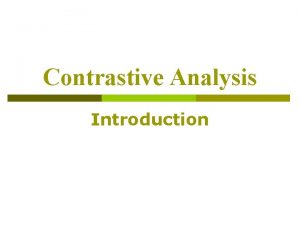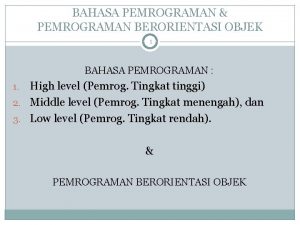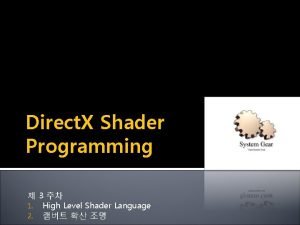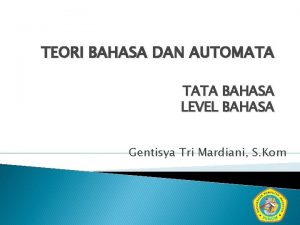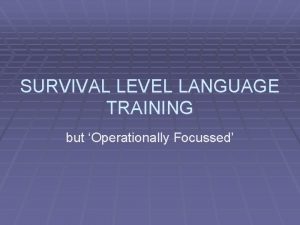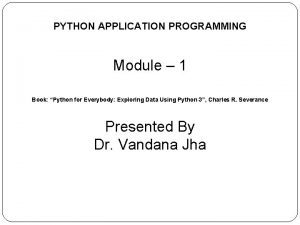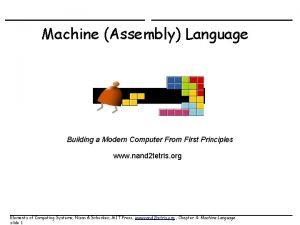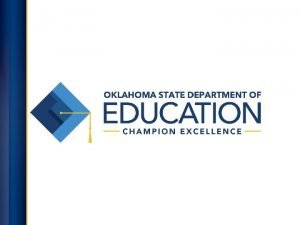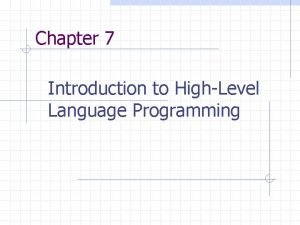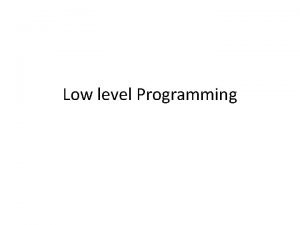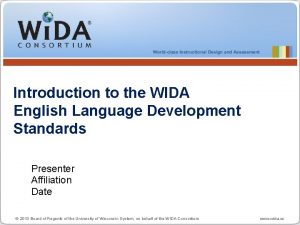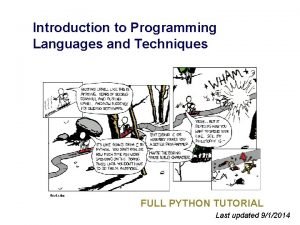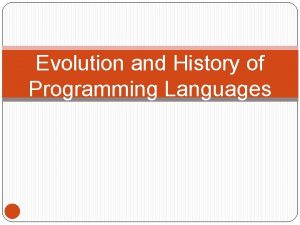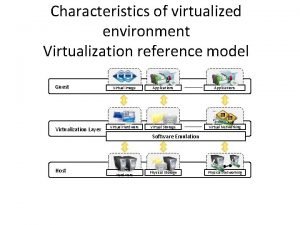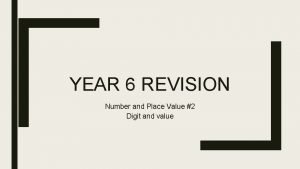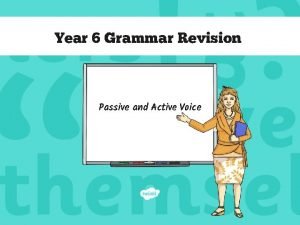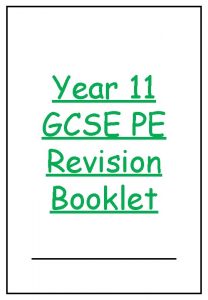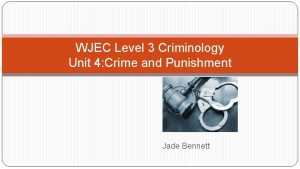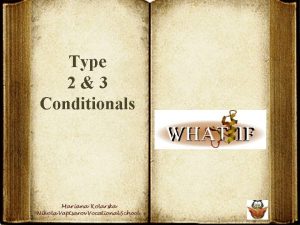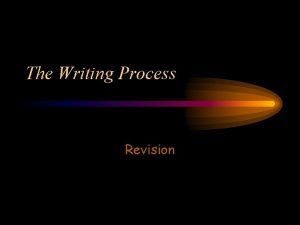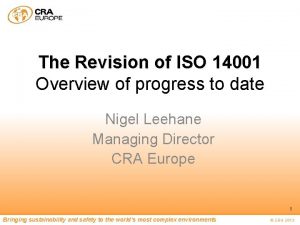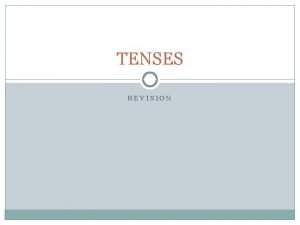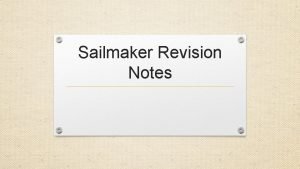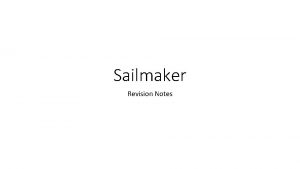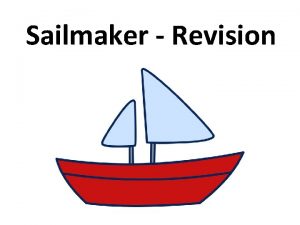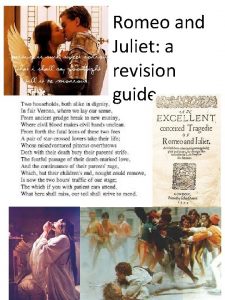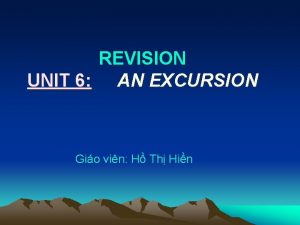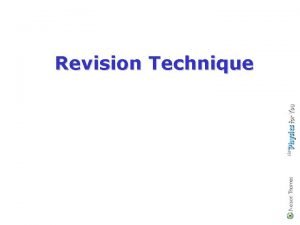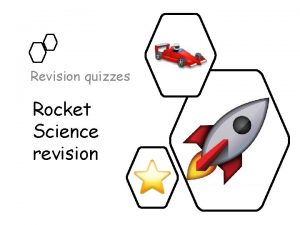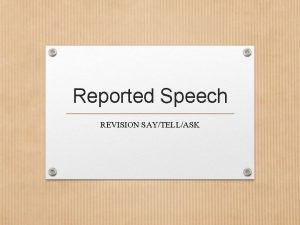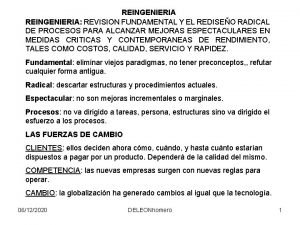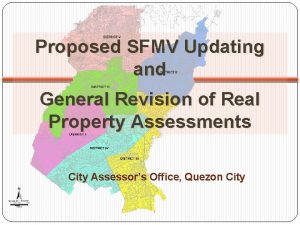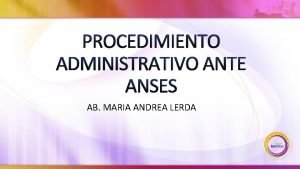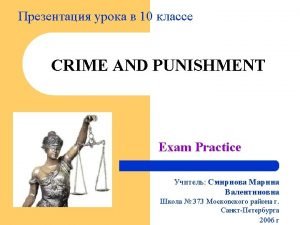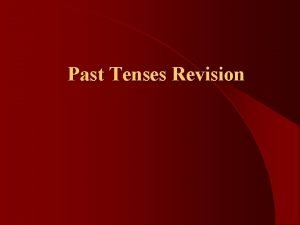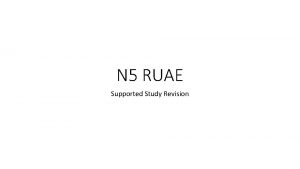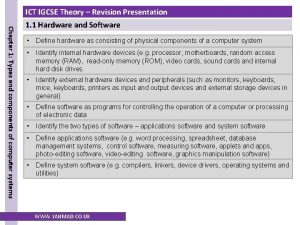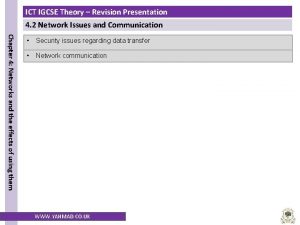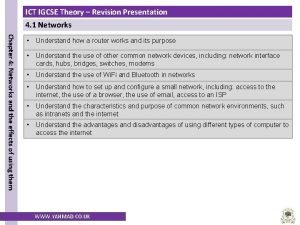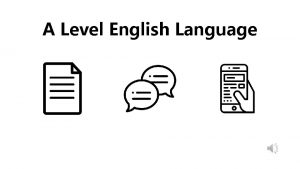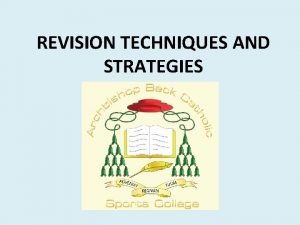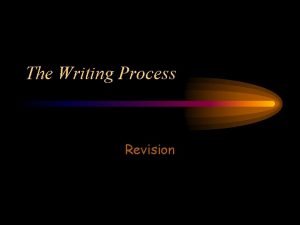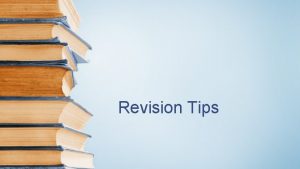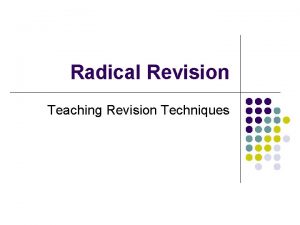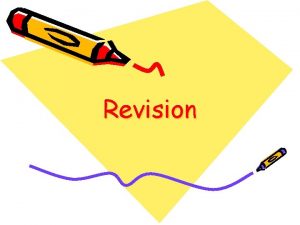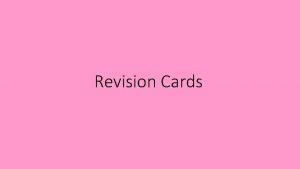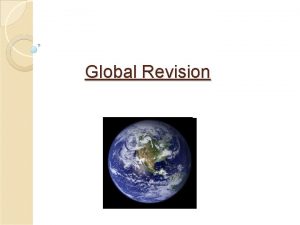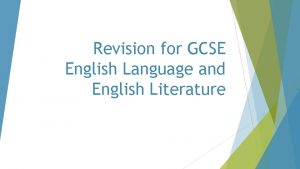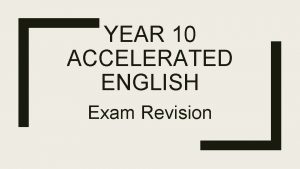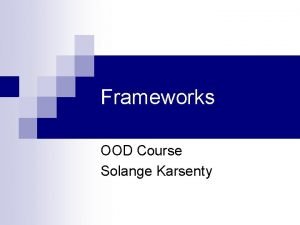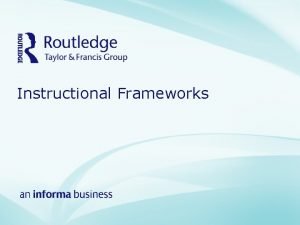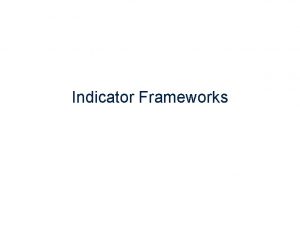A LEVEL ENGLISH LANGUAGE Revision FRAMEWORKS How to
















































































































































- Slides: 144

A – LEVEL ENGLISH LANGUAGE Revision

FRAMEWORKS How to Structure a Response in an Exam

GRAMMAR • Sentence Types • Sentence Functions • Pronouns • Length of Utterances or Sentences • Syntax • Use of Modals Verbs • Passive or Active

PHONOLOGY • Alliteration • Assonance • Onomatopoeia • Rhyme • Rhythm • Accent/Pronunciation • Phonetics

GRAPHOLOGY • Use of pictures/graphics/columns • Arrangement of Words • Juxtaposition of Words and Images • Font Size and Style

DISCOURSE • Written or Spoken (Mainly Spoken) • Non-Fluency Features • Filler and Pauses • Discourse Structure • Informal Features • Issues surrounding power, gender etc

LEXIS • Colloquial/slang or formal lexis • Specialist or Non-Specialist Lexis • Formality/Register • Semantic Field

SEMANTICS • Imagery: Metaphors, Similes • Tone: Humour, Irony, Seriousness • Allusions to Popular Culture • Puns etc • Connotations • Collocations

PRAGMATICS • Speech acts & Indirect • Visual Context • Grice’s Maxims and Co-Operative Principle • Politeness Principle • Context

TERMINOLOGY

SENTENCES • Syntax Sentence Structure • Minor A Sentence that doesn’t contain a verb • Simple Contains only one clause, a single main verb • Compound Two independent clauses, joined using a co-ordinating conjunction (and, but, so) • Complex An independent clause and a subordinating clause, linked using a subordinating conjunction (because, although, whereas, however) • Declarative Statements that give information • Imperative Start with a verb, used to give orders, instructions, directions etc… • Interrogative Asks a questions, so contains a question mark • Exclamatory Have an expressive function, so end in an exclamations mark

NOUNS Can be split into Proper Nouns or Common Nouns • Proper Nouns • Common Noun • Names of people • Concrete Things you can physically see or touch • Names of Place • Abstract Things which don’t doesn’t exist • Collective Groups of people, animals or things

ADJECTIVES Type of modifier, they describe nouns • Simple long • Comparative longer – er • Superlative long – est

ADVERBS Type of modifier, they describe verbs • Adverbs usually end in -ly

PRONOUNS • Personal Pronouns Replace the subject or the object of the sentence - 1 st Person: I, Me, We, Us - 2 nd Person: You - 3 rd Person: He, She, It, Him, Her, They, Them • Possessive Pronouns Shows possession - 1 st Person: Mine, Ours - 2 nd Person: Yours - 3 rd Person: His, Hers, Its, Their • Reflective Pronouns Indicate that the object of a verb is the same as its subject. - They end in –self or –selves • Indefinite Pronouns that do not refer to specific persons or things - Someone, Anything, No-one, Everything • Demonstrative Pronouns ‘pointing’ at someone or something - This, That, These, Those (If any of these four words are placed in front of a noun, it becomes a determiner) • Relative Pronouns Act as linking words. They are always placed immediately after the noun they refer to - People: Who, Whom, Whose - Things: Which, That • Interrogative Pronouns Used when asking a question - Who, Whose, Which, What

CONJUNCTIONS ‘Joining words’ – Join together different parts of a sentence • Coordinating Conjunctions And, But, Or, So • Subordinating Conjunctions Because, Although, Unless, Until

PREPOSITIONS Indicate in some way how one thing is related to something else • Relating to: • Position At, On, Opposite • Direction Into, Past, To • Time Before, During, After A preposition shows the relationship between the noun that comes after it and something else in the sentence

DETERMINERS Come before nouns and refer directly to them • Definite Article The • Indefinite Article A/An • Possessive Determiners My, Our, Your, His, Her, Its, Their • Demonstrative Determiners This, That, These, Those

PHRASES • Noun Phrase Usually has a noun or pronoun as its head word Usually have a pre-modifying determiner (the) • Verb Phrase Usually contains a main verb and any accompanying auxiliary verbs I may see him

VERBS “to be”, “is was”, “were” are all verbs • Infinitive “To” followed by a verb • Split Infinitive when something becomes in between “to” and a verb, considered wrong my prescriptivists • Auxiliary verbs “Helping Verbs” - Can be split into Primary or Modal • Primary: Be, Have, Do Can be used to: - Indicate when something happened - Add Emphasis - Construct questions - Negatives • Modal: Can, Will, Shall, May, Must, Could, Would Can: - Alter the Tone - Make something more polite

VERBS • Material Describes actions or events • Relational Describes states of being or are used to identify • Mental Describes perception, thought or speech • Dynamic Verb Processes where there is a change in state over time • Stative Verb Processes where the situation remains constant

ACTIVE AND PASSIVE • Active Where the focus of the sentence is the subject performing the action of the verb • Passive Where the focus of the sentence is the recipient of the action described

SEMANTICS • Similes Comparison using ”like” or “as” • Denotation The meaning/definition of a word or phrase • Metaphor Describes something as if it was something else • Connotation The association a word has • Idiom Word or phrase which means something different than its literal meaning • Collocations Group of words usually found alongside each other • Synonym Words with similar meanings • Antonym Words which means are opposite • Oxymoron Brings two conflicting ideas together

PHONOLOGY • Phoneme Smallest unit of sound in a language. B-A-T has three phonemes • Syllables Phonemes combine together to form syllables. A single unit of speech • Onomatopoeia When the word sounds as its spelt • Alliteration Two or more words begin with the same sound • Rhyme words have similar endings

ACCENT AND DIALECT

TERMINOLOGY • Accent The pronunciation of words • Dialect The language used dependent on region. Features of vocabulary, grammar and pronunciation • Received Pronunciation The accent associated with the upper class • Standard English The vocabulary and grammar associated with educated users of the language, it is taught in schools • Stereotypes A generalised, simplified view of a group of people • Convergence When the speech styles move closer together • Divergence When the speech styles move away from each other • Covert Prestige The prestige that derives from behaviour that goes against the norms of ‘respectable’ society • Overt Prestige that attaches to respectable, socially desired behaviours • Hierarchy Members ranked according to status or authority

STANDARD ENGLISH • David Crystal identified five key characteristics: 1. It is not regionally based 2. Has distinctive features of grammar, vocabulary and orthography… but not pronunciation. Standard English can be spoken by any accent 3. It is the most prestigious variety of English 4. It is the most widely understand 5. Commonly used in printed texts • Attitudes to Standard English: • Regarded by many as ‘correct’ form of English • Sloppy or incorrect use of the language usually refers to derivation from Standard English

RECEIVED PRONUNCIATION • It is estimated that only 3% of the population now speak pure RP • Modified RP: RP accents with regional features

ATTITUDES TO ACCENT EVIDENCE • RP Speakers emerge less favourable than regional accents in terms of personal attractiveness • They score less well for qualities such as sincerity, good-naturedness and sense of humour • Rural accents are viewed more positively CAUSES • RP is associated with authority and status due to it being used by the upper class, many do not belong in this class, so therefore feel socially distant • Most people have a positive view of the countryside, so respond favourably to rural accents • The media enforces stereotypes

ATTITUDES TO ACCENT • Prescriptivists An approach to the study of language that favours rules identifying correct and incorrect language use • Descriptivisits An approach to the study of language that describes how language is used but does not judge language used as correct or incorrect • Dialect Levelling Dialect differences decrease. Speech forms are becoming similar over time resulting in a reduction of language diversity

“IT WAS REPORTED THAT…” • 28% of Brits feel discriminated against because of their accent • 8% of Brits have made themselves sound more posh

ESTUARY ENGLISH • Origins: WW 2 – Movement of population from London around Britain meant other places were ‘under attack’ and have been replaced with Estuary English • Features: ● Glottal Stops ● L-Vocalisation • Speakers are aiming for a ‘classless profile’ • ↑ Could lead to dialect levelling

CONVERGENCE AND DIVERGENCE • Convergence language differences move closer together • Divergence language differences move further apart • RP Accent ↓ softens accent to suit regional accent • RP Accent ↑ strengths accent • Region Accent ↑ softens accent to suit RP accent • Regional Accent ↓ strengthens accent

SPOKEN LANGUAGE

TERMINOLOGY • Adjacency Pair Unit of conversation that involves “turn-taking”, exchange of one turn each by two speakers • Back-Channel Support A way of showing a speaker you’re following/understanding what they are saying • Contraction A shortened form of a word or group of words with an apostrophe marking the missing letter • Deixis/Deitic A word or phrase (such as this, that, those) that points to the time, place or situation in which the speakers is referring to • Discourse Marker A word or phrase used to organise, connect or manage what we say • Elision Removal of an unstressed syllable/letters in order to mix words • Ellipsis Missing words from a sentence • False Start Unplanned speech, the speaker says something before then re-arranging what they were saying • Filler A meaningless word or phrase which marks a pause or hesitation in speech • Hedges A word or phrase which makes a statement less forceful/assertive, makes it less direct

TERMINOLOGY • Idiolect A person’s specific, unique way of speaking • Pragmatics Aspects of meaning (read between the lines) • Sociolect The dialect of a particular social class/group • Prosodic Features The auditory qualities of sound, pause, pitch, stress, volume, tempo • Utterance A spoken word, statement or sound • Repairs When a speak recognises a speech error and repeats what has been said with a correction • Interactional Talk General social talk between two people • Transactional Talk Conversation between at least two people with the purpose of achieving a goal • Phatic Talk “Small Talk”, used to communicate socially rather than information • Non-Fluency Features Terms for mistakes and corrections that we make as we speak and think • Paralinguistic Features “Tone of Voice”, the vocal effects we speak • Tag Question A brief question added to a declarative sentence to engage the listener • Topic Loop Coming back to the original topic • Turn-Taking A speaker starts and finishes before another speaker starts • Vague Language which doesn’t provide detail, it isn’t practised

SOCIAL GROUP

TERMINOLOGY • Idiolect Someone’s individual/unique way of speaking • Sociolect A dialect associated with a specific social group • Social Group/Network A group of people with something in common or similar connections • Open Network Contacts don’t really know each other • Closed Network Contacts all know each other • Density Either high or low, whether members are in touch with each other • Familect Home dialects in which words are given private meanings • Code-Switching from one way of speaking to another way of speaking • Slang Informal words or phrases associated with a particular group • Vernacular The language/dialect spoken by ordinary people of a country or region

WHAT FACTORS MAY AFFECT SOMEONE’S IDIOLECT? • Social Class • Age • Peer Group • Media • Religion • Occupation • Gender

TEEN SPEAK • Gary Ives: Ø Used a group of 17 year olds from the same West Yorkshire secondary school, they remembered words such as kissy-chase Ø Mostly words connected to childhood games but couldn’t recall specific words Ø They could easily give examples to how they spoke as a teenager Ø They used taboo language, dialect and slang

TEEN SPEAK • Anita Senström: Ø Focused on non-standard grammatical features Ø Found teens used: Irregular turn-taking, overlaps, indistinct articulation, word shortenings, teasing, verbal duelling, slang, taboo language and language mixing

TEEN SPEAK • Penelope Eckert: Ø Discovered slang is used to ‘establish connections to youth culture and separate themselves from older generations. ’ Ø Her study into linguistic features of teenagers could not be interrupted for everyone Ø She found language is specific to their peer group

TEEN SPEAK • Ignacio Palacias Martinez: Ø Focused on use of negatives Ø Found that teenagers use negatives more frequently compared to adults Ø 1/3 of these were due to orders, suggestions and refusals Ø Teenagers were found to be more direct, whereas adults were more concise of how they spoke

TEEN SPEAK • Unni Berland: Ø Focused on the use of tags (innit, yeah, right) Ø Social class was a big factor Ø “Okay” was used more by boys, but “innit”, “yeah” and “right” were used equally by both genders

OCCUPATIONAL LANGUAGE

TERMINOLOGY • Jargon Special words or expressions used by a professional or group that outsiders won’t understand • Mitigated Imperatives A command which has been pacified or diminished (please) • Field-Specific Lexis Words that relate to a certain group • Discourse Structure The way something is structured • Restricted Occupational Lexis Words/Phrases only used in certain professions • Discourse Community A group of people who share a set of discourses, “groups that have goals or purposes, and use communication to achieve these goals” • Variant Occupational Language Words/Phrases used in multiple fields • Coded-Language Using code-words, such as initialisms and acronyms, to say something. Only used in a specific occupation • Giles Accommodation Theory “We adjust our speech to suit others” • Shared Knowledge, information and skills is shared between others • Power Asymmetry A marked difference in the power status of individuals involved in discourse • Unequal Encounter Highlighting the power on speaker has over another • Power Participants A speaker with higher status • Constraints Ways in which powerful participants may block or control contributions of less powerful participants

WARING (1999) Classified types of powers in the following way: • Instrumental Power used • Political Power held by to maintain and enforce authority those with the backing of the law • Personal Power held by individuals as a result of their roles in organisation The Police • Social Group Power held as a result of being a member of a dominant social group • Influential Power used to influence or persuade others Teachers Lawyers Family Friends The media

NORMAN FAIRCLOUGH (2001) • Synthetic Personalisation • Members’ Resources The way in which advertising and other forms of communication used personalised language such as the second person pronoun “you” to construct a relationship between text producer and receiver. The amount of knowledge and information that readers use in order to interpret texts such as adverts. Advertisers usually explicitly plan on this to create an image of the text. (Sell a lifestyle)

DREW AND HERITAGE (1992) • Goal Orientation Participants in workplace conversation usually focus on specific tasks or goals • Structure Workplace and professional interactions maybe structured in specific way • Turn Taking Rules or Restrictions In some professional context (e. g. the courtroom) there are special turntaking rules in operation. But even when no special rules exist, there maybe an unwritten restrictions on who speaks when. • Asymmetry Work place and professional interactions are often asymmetrical, that is often one speaker has more power and/or special knowledge than the other. Examples are conversations between a boss and an employee, or a doctor or patient • Allowable Contributions There maybe restrictions on what kinds of contribution are considered ‘allowable’, i. e. on what participants may say

BLENDED-MODE TEXT Mixture of the physical channel of communication. Speech and Writing

TERMINOLOGY • Acronym Sounds like a word, uses initials to form a word • Initialism Pronounced letter by letter, formed from the initial letter or letters of several words • Homophonic Representation The use of single letters and numbers to represent words based on a similarity in sound (M 8) • Vowel Omission Leaving out vowel sounds in textspeak and other electronic communication (Kwl) • Phonetic Spelling A spelling that represents the sound of a word as opposed to its conventional spelling • Deviant Spelling Deliberately non-standard spelling for effect • Replication of Speech Patterns The use of phrases, constructions and presentation to recreate and stimulate visual and auditory features of spoken language (Um…) • Emoticons & Smileys Pictures of faces used to show emotion. They can also be created using punctuation ((: ) • Ellipsis Removing words to make the utterance shorter • Synchronous The online conversation takes place in real-time with immediate turn-taking • Over-lexicalisation Using more words than you really need to convey an idea, to add emphasis • Reduplication Letters repeated to add emphasis (Sooo…) • Neologism A new word that comes into the

GENDER

GENDER • Sex = Biological Differences • Gender = Socially Expected Characteristics (Therefore a social construct) • Socialisation Process A process by which individual’s behaviours are conditioned and shaped. It begins when we’re children • “It became illegal to write a job advertisement in a way only one sex can apply” – Sex Discrimination Act (1975)

ROBIN LAKOFF (HIT HW) • Hedges Punctuate speech with uncertainty • Intensifiers Avoiding strong statements or committing to an opinion (Uncertainty) • Tag Questions Adds uncertainty to a statement so a speaker doesn’t impose her point of view • Hypercorrect Grammar Women more likely to comply with grammatical rules • Women’s Work Words Women’s vocab included trivial words because they are relegated to decisions about unimportant subjects

ZIMMERMAN AND WEST (SOI) • Overlaps Men overlap with women more (100% of overlaps were men) • Interruptions 98% of interruptions were done by men. They interrupted women more than same sex conversation. Women also interrupt other women more than they do men • Silences Single sex convo: 1. 35 secs, Mixed sex convo: 3. 21 secs. Women kept being interrupted so spoke less

DEBORAH TANNEN (WIIS) • Women’s Work Words Men usually assume role of information giver or fixer because this reinforces strength and status • Interruptions and overlap can be supportive • Imperatives Men use more. Use them to their sons more than their daughters. Women used cloaked imperatives “Lets” • Silences Women see listening and supporting as essential to group bonding. They assume a turn will be granted

JENNIFER COATES • Hedges Men hedge less • Tag Questions Men use questions to seek information from each other • Minimal Responses Women make well-place minimal responses but the men made them too late. This indicated a lack of interest and support, which led to women falling silent • Weak Expletives Women use ‘Oh Dear’ instead of taboo terms

OTHER • Mira Komarovsky 58 working class USA couples. Women spoke about family, personal matters. Men spoke about business, sport, work, local politics • Pamela Fishman Women use 3 times more tags and the hedge “you know” 5 times more. Not showing uncertainty but to keep the conversation going (Conversational Labour) • Janet Holmes Tag Question: - Modal Tags = Seek Info - Facilitive Tags = Draw in listener - 61% Modal Tags were men - 75% Facilitive Tags were women

DEFICIT MODEL • Idea that the way men speak is ‘the norm’ • Women are socialised to act & talk in different ways to men • Lakoff argued for a ‘deficit model’ (one language is inferior to the other), socially engineered

DEFICIT MODEL • Lakoff: Because tradionally women’s terms are marked with suffixes such as –ette (makes something more feminine) It is a deviation from the norm The power lies in the unmarked norm, the male form (‘woman’ comes from ‘man’) Women trained to talk like ladies Ladies do not draw attention to themselves for all the wrong reasons (Do not swear) Unfeminine if talked like a man Tag Questions: Signs of uncertainty, ask for reassurance

DEFICIT MODEL • Dubois & Crouch (1975) Academic situations men used tag questions more than women (To seek information) Education helps bring genders together

DEFICIT MODEL • Other Some aspects of women’s language signals hesitancy but does depend on context O’Barr & Atkins examined hedging in the courtroom ↓ People judging less believable if they used hedges interpreted this as signs of powerlessness Hedges/Fillers can be seen as important utterances: phatic, smoothing interpretation communication, allowing speakers to seem relaxed Lakoff did not take into consideration class, race, occupational, etc

DOMINANCE MODEL • Dale Spender & Thorne and Henley continue the debate but looked at how men dominated and controlled women and language • Men were seen to control topics of conversation • Men interrupted more and talked more • Lakoff’s research was viewed in a different way

DOMINANCE MODEL • Question Forms: Lakoff: Women use this feature more than men and it showed uncertainty Pamela Fishman: Found this to be the case mixed sex conversation women used questions to keep the conversation going. Termed this to be part of a woman’s ’conversational labour. ’ Men are more likely to respond with silence than a woman

DOMINANCE MODEL • Zimmerman and West (1975) Concluded ‘females are a class of speakers whose rights to speak appear to be causally infringed on by males. ’ Noticed 98% of interruptions in mixed sex conversations were by men Men use interruption as a way of getting control over topics

DOMINANCE MODEL • Janet Coates (1989) Women use back-channelling more, keep the conversation going • Swacker (1975) Researched quantity of speech Found men spoke for three times longer than women • Dale Spender People think that women speak more than men because we judge a woman against silence

DIFFERENCE MODEL • A picture seemed to emerge from the above research of bullying men and meek women *NOT THE CASE* • None of these models take in cultural differences • Example: Jewish Culture – There is a high degree of interruption, overlap and topic control in both genders speech

DIFFERENCE MODEL • Deborah Tannen • “You just don’t understand: Men and Women in conversation” • Looked at power and solidarity Women are trained to pay more attention to solidarity and intimacy Men are trained to be competitive, and pay more attention to aspects of power Women trained to draw out others, establish rapport and cooperation ↑ led to conflict in mixed sex conversations as we follow different ways of speaking to fit with our different agendas Language is a performance Tannen shows that each gender understands these performances in a different way Men see conversation as an exchange of information. Women see it as a chance to relate to the other person. Men = Report, Women = Rapport

DIFFERENCE MODEL • Janet Holmes & Peter Trudgill The sexes are not different cultures People are more influenced in how they speak by their social class rather than gender We need to consider gender within language, however gender is just one of the factors to influence language

DIVERSITY • Idea takes into account the fact that not just gender influences our spoken language: Age, Education, Culture, Social group etc affect our language choice. • We need to chose language carefully according to our audience context and the purpose of our conversation

STUDIES

LABOV NEW YORK STUDY • Studied the final or preconsonatal (r) • It has considerable prestige in NYC • Three department stores: Saks (Upper), Macy’s (Middle) & Kleins (Lower) • Asked which floor something was on first responses were spontaneous, second were careful Conclusion - Increase in /r/ in careful speech - Saks used /r/ more - Kleins used least - Macy’s showed greater upward shift when asked to repeat, due to overt prestige Social class will affect the manner of how English is spoken and pronounced

TRUDGILL – NORWICH STUDY • Studied the final constant sound, “-ng” • Focused on middle & working class (split into upper, middle & lower) • Zone Sampling: 10 speakers from each category + 10 children from 2 schools • Used questionnaires Conclusion - More careful speech = More likely –ng pronounced - ”Walkin-” higher in lower social classes - “-in” used more in men (All social classes) - Women said they use ”-ing” more than they did - Men use “-in” less than they thought Class is more of a determiner of non-standard “-in” than gender LMC & UWC were most susceptible to the prestige of RP. Men use N/S forms more, so women are more susceptible to overt prestige than men (who used covert prestige)

MILROY’S BELFAST STUDY • Studied 3 working class families in Belfast • The areas had high unemployment • Looked at N/S forms in different social groups Conclusion - A closed network used more N/S forms - Occurred more in men due to women having less dense social networks - However, this changed due to social pressures so varied the results Social networks affect N/S form usage more than gender, however social class plays a factor in this

LABOV – MARTHA'S VINEYARD STUDY • Studied the fisherman on the island which had the most closed social group • Focused on the realisation of the diphthong (aw) & (ay) Conclusion - Younger speakers spoke more towards the islands way of speaking - Heaviest users of this were young men who identified themselves as “Vineyarders” - They would exploit their N/S dialect Labov discovered closed network fisherman exaggerated features already in their speech. Did this maintain tradition and separate themselves from visitors to form a social group with superior status

LANGUAGE CHANGE

LEXICAL CHANGE • Lexical Change When new words are added to our vocabulary or if old words fallout of use • Blend Parts of words are joined together, blended together (Motel= Motor + Hotel) • Borrowing Words are taken from another language • Derivation (or Affixation) A morphological process where an affix is added to a root morpheme • Internal Borrowing Words are taken from other English Speaking countries • Clipping off a word • Initialism Abbreviation to letters, pronounced letter by letter • Acronym Abbreviation to letters, pronounced as a word • Compound When words are combined to form a new, larger word or expression. (Blackbird = Black + Bird) • Conversion When the word class of an existing word changes, creating a new use for the word (To Bottle) • Back-Formation A type of shortening in which a word (usually a noun) is shortened to form a word of another type (Usually a verb) • Archaism Words that are no longer used • Eponym A word or name derived from a proper noun

SEMANTIC CHANGE • Semantic Changes in the meaning of words • Narrowing The opposite of broadening, a word becomes more specific in its meaning • Metaphorical Change Words that acquire new meanings because they begin to be used metaphorically • Idioms Something which doesn’t follow its literal meaning • Pejoration When the change in meaning becomes less favourable • Amelioration When the change gives the word a meaning that is more positive and pleasant • Broadening The meaning of a word broadens, retains its old meaning but takes on an added meaning • Weakening Words losing some of their original force or strength over time • Euphemism A mild or inoffensive way of describing something distasteful or unpleasant

LANGUAGE CHANGE EARLY MODERN ENGLISH: 1450 - 1700 LATE MODERN ENGLISH: 1700 – PRESENT DAY • Pronouns = thou, thee, thy • Pronouns = youse • Interrogatives = whom & whose = more archaic pronouns = subject & verbs used instead • Interrogatives = why, what, where • Negatives = double negatives • Negatives = limited double negatives • Inflections = est & eth = A lot more inflections • Contextual Factor = Introduction of printing 1476 by William Caxton • Inflections = Use to show plural • Contextual Factors = Standardization = The first dictionary in 1755 = Roman’s coming to Britain and bringing Latin = Growth of Education = Norman Invasion in 1066 = Expansion of British Empire

GRAMMATICAL CHANGE Inflections: indicate the grammatical form of a word • Nouns • Adjective • Tense: • Number: • Comparative • Present walks • Singular actor • Superlative • Past walked • Plural actors • Person: • Gender: • First Person walk • Male actor • Third Person walks • Female actress • Verbs • Number: • Singular walks • Plural walk Modern English has much less inflections compared to Old English were reliant on them, “doth”, “dost”

GRAMMATICAL CHANGE Pronoun s: • ”Thou”, “Thee”, “Thine” have disappeared from the language

GRAMMATICAL CHANGE Who & Whom • According to traditional grammar, the personal pronoun ‘who’ should change to ‘whom’ when it refers to the object in a clause • The use of ‘whom’ has been regarded as excessively formal, though the word maybe kept alive by its continued regular use after prepositions

HISTORY OF ENGLISH • Early East Coast American: First settlers in America were pilgrim fathers from English who were fleeing from religious persecution (17 th Century) A Native American named “Squanto” saved the pilgrim fathers from harsh winters. Consequently saving the English Language in America There were less than a dozen borrowings. They wanted to recreate what they already knew so it was less frightening • Teaching English in America: The 18 th century view on America English was that most English people thought Americans spoke English better Webster’s Dictionary sold 60 million copies, making a massive influence on spelling, removed illogical spelling & changed pronunciation • Frontier America: The effects of immigration on American English helped introduce different languages, such as French, Scottish, Irish Gambling created new phrases such as “poker-face” more slang words & idioms Native American language experience conversion such as “scalp” changing from a noun to a verb

STANDARDISATION • Why Standardise Language? • Who is responsible for Standardising language? So speakers and writers can effectively communicate with one another Standardisation has a long history Places value on a particular dialect of a language, giving it prestige and national identity. Printing allowed conventions of spelling and punctuation to evolve People’s desire to stabilise, fix and codify the language became stronger • 1755 – Samuel Johnson recorded and described the words in use at the time in the first major dictionary • 1762 – Bishop Robert Lowth’s ‘Short Introduction to English Grammar’ • 1794 – Lindley Murray’s ‘English Grammar’

JOHNATHAN SWIFT • 1712: He published ‘A Proposal for Correcting, Improving & Ascertaining The English Tongue. ’ Main Concerns were a dislike of: • Vagueness in Language • Shortened Words • Unnecessary Contractions • Words invented by ‘some petty fellows’

DIFFICULTIES/INCONSISTENCIES IN ENGLISH SPELLING • Some words have silent letters • Homographs – Words that are spelt the same but sound different • Homophones – Words that are spelt differently but are pronounced the same way

OLD ENGLISH ALPHABET • The Roman Alphabet was introduced to Britain in the 6 th century • Did not include some consonants: j, q, v, k and z were rarely used • Some additional consonants were used that we have subsequently lost from the alphabet: ð (eth), Ȝ (yogh), þ (thorn), ƿ (wynn) • More vowels than we currently have in our alphabet • Words were spelt as they sounded

NORMANS INFLUENCE ON SPELLING Some old English letters were abandoned • æ, k, q, x, z, ‘th’ were introduced • ‘th’ was increasing used instead of thorn or eth • “g” was used in place of yogh

CAXTON’S INFLUENCE ON SPELLING • Established a spelling system so that his texts could be accessible for everyone • He was fairly irregular with his own spelling • His Flemish typesetters didn’t contain thorn, eth and yogh • This meant they were replaced with ‘th’ and ‘g’

GREAT VOWEL SHIFT • Took place from the mid 14 th century to mid 18 th century • There was a gradual change in vowel pronunciation • A move towards a long vowel

LANGUAGE CHANGE THEORIES • Prescriptivist An approach to the study of language that favours rules identifying correct & incorrect language • Descriptivist An approach to the study of language that does not judge language as correct or incorrect • Robert Burchfield (1978): Disintegration The English Language will disintegrate into a collection of related, by largely separate dialects. Predicted within a few centuries, the speakers of British & American English will be unable to understand each other. • Jean Aitchison: Crumbling Castle Language is a beautiful old castle that needs preserving. It crumbles when examined carefully Infectious Disease We ‘catch’ change from those around us. It is brought through social contact Damp Spoon Language change is due to laziness • Charles Hockett: Random Fluctuation Theory Random errors and events lead to language change

LANGUAGE CHANGE THEORIES • Lexical Gaps A word will be invented, converted or borrowed in order to fill a gap in usage, as well as a phonological gap • Chen (1968 & 1972): S-Curve Model Language change happens at a slow rate at first, until a certain number of people use it, when it accelerates, before levelling off • Substratum Theory Language changes primarily through contact with other languages • Bailey (1973): Wave Model A person or group close to the epicentre of language change will pick it up, whereas a person or group further away will less likely adopt it • Halliday: Functional Theory Language changes according to the needs of its users. Mainly lexical change: 1. New Discoveries/Learning/Invention 2. Technological Words 3. Slang

WORLD ENGLISHES

TERMINOLOGY • World Englishes A term for emerging localized or indigenized varieties of English, especially varieties that have developed in territories influence by the UK & USA • Lingua Franca A language that is adopted as a common language between speakers whose native languages are different • Global English The use of the English Language as a common means of communication across cultures (A lingua franca) • International English The concept of the English Language as a global means of communication in numerous dialects, and also the movement towards an international standard for the language • Diaspora The dispersoal is a large group od people with a similar heritage or homeland who have since moved out to • First Language (L 1) First language that’s learned by an individual • Second Language (L 2) Second language that’s learned by an individual • Pidgin Trade Language = not the first language of the speakers, can develop into a language of its own • Creole Children of pidgin speakers learn this language as their first language. Picks up a wider vocabulary • Acrolect An of official language variety where a creole is spoken. The most formal • Basilect Most informal style people use • Mesolect Middle standard of language, in between standard and colloquial

THE FUTURE OF ENGLISH • • English today is the global language and is more widely used than any other language It is the recognised international language of business, technology, politics and popular culture DISINTEGRATION • Although English is spoken in many different countries of the world, each of these countries has its own variety of English • The English that is used in each country is influence by the pre-existing languages of the country • Robert Burchfield: Disintegration Theory • A comparison is Latin, now a ‘dead’ language. French, Italian and Spanish, now three clearly distinct languages, all developed from Latin UNIFORMITY • A contrasting vision predicts development in the opposite direction • World Standard English is said to be emerging, with the different varieties of English growing closer together • British English & American English seem to be decreasing in their differences • In England, the loss of much regional dialect vocabulary points to the development of a common variety of English • Accents appear more resistant to change, but the rise of Estuary English suggests that there is also a growing phonological uniformity

CHILD LANGUAGE ACQUISITION Spoken

PRAGMATIC DEVELOPMENT The study of the part that language plays in social situation and social relationship, As well as learning the sounds, words and meanings of language.

THE FUNCTIONS OF CHILDREN’S LANGUAGE Halliday (1975) – identified seven functions that language has for a child in their early years • Help Satisfy its Physical, Emotional & Social Needs: • Help the child come to terms with its environment: Instrumental When a child uses language Heuristic When language is used to gain to express its needs knowledge about the environment Regulatory This is where language is used Imaginative Used to tell stories and jokes to tell others what to do (e. g. Go Away) Interactional Where language is used to make contrast with others and form relationships Personal Used to express feelings, opinions and individual identity Representational Use of language to convey facts and information

EARLY YEARS • Children are introduced to the language of adults before they can even speak • Adults speak a lot to children even though they cannot speak back • Adults often continuously repeat an utterance to an child in the hope they will repeat it back • Interactions between child and parents prepares the child for later participants on conversation

BANCROFT (1996) – ‘PEEK-A-BOO’ • Turn taking is involved, although the child does not understand, the adult acts if it does • Each participant responds to the contribution made by the other • Participants have a common purpose and understand the sequence that they must follow • Participants enjoy the activity Typical patterns is that the adults begins conversations and that the child plays a small part in it. This part grows as the child gets older

FIRST CONVERSATIONS • Children’s first utterances are often statements and not questions • Child may ignore other speakers present • Conversations will often be dependent on the adult’s input to keep it going • However, children will start to express its needs and use of language for social interactions

LATER DEVELOPMENT • A child’s conversation skills develop considerably between ages two and four • Children become more active in conversation and will initiate them • They learn conventions of turn-taking and begins to respond to questions and greetings • They learn how to be polite (e. g. saying please and thank you) • They learn more sophisticated methods of language use • Youssef (1991) – studied Janet: a 3 year 9 month old girl from Trinidad, who was able to ode switch between Standard English for her mother and Trinidadian English for friends and a family helper

GRAMMATICAL DEVELOPMENT Concerned with syntax

ONE WORD STAGE • You’re about one years old when you speak your first word • You speak in single word utterances • If more than one words appears to be involved, its because they’ve learnt it as a single unit (Allgone) • Single words convey more complex messages which are called holophrases: ’Juice’ could mean “I want some juice” or “I’ve split some juice” The situation, use of gestures and intonation help the parents understand what the child means • Although the child’s utterances are limited their understanding of syntax is more advanced and this is shown because hey respond to two word utterances/instructions (Kiss Daddy)

TWO WORD STAGE • You’re about 18 months when two word utterances begin to appear • The two words are usually in a grammatically correct sequence, often subject + verb (Jenny is sleeping becomes Jenny sleeps) • When a child repeats what an adult says it may omit some of the words but what they say will usually be in correct grammatical order • A child’s two utterances can express a range of complex of meanings: Bloom = observed that same sentences may be used to express different meaning. They may express possession or someone performing an action or to explain location • The uncertainty of some two word utterances arises partly because inflectional affixes are absent

TELEGRAPHIC STAGE • You’re about 2 years old when you start pronouncing 3 & 4 word utterances • Some of them will be grammatically complete and others will have grammatical elements missing • The condensed structure of these utterances explains why they are called telegraphic like telegrams, they include key words but omit words like determiners, auxiliary verbs & prepositions • Progression during this stage is rapid, as by 3 years old, the items that were omitted are beginning to be used regularly • By the age of five many of the most basic grammatical rules have been learned whilst some have not yet been mastered (Post-Telegraphic Stage)

LEXICAL AND SEMANTIC DEVELOPMENT Words = Lexical Development Word Meanings = Semantic Development

HOW FAST DO CHILDREN ACQUIRE VOCABULARY • Children usually begin speak by the end of their first year: ✷ 18 Months = 50 Words ✷ Aged 2 = 200 Words ✷ Aged 5 = 2, 000 Words ✷ Aged 7 = 4, 000 Words • These figures refer to words actually used. For Example: An 18 month child may speak 50 words but understand 250 • Children may be able to speak a word, but they won’t necessarily understand it, this process takes additional knowledge

FIRST WORDS Studies have shown there are predictable patterns in first words: • Names: Mummy & Daddy • Food: Drink, Juice, Milk, Apple • Animals: Dog, Cat, Duck • Toys: Ball, Doll • Others: Bottle, Keybook • Humans: Baby • Clothes: Sock, Hat • Vehicle: Car, Boat, Truck • Nouns make up the biggest class of words, and are usually concrete. This is then followed by verbs • First verbs are action verbs • Words that only serve a grammatical function are absent, such as ‘the’, ‘of’ and ‘to’

UNDEREXTENSION AND OVEREXTENSION Underextension: Overextension • Common semantic error made by children when they only refer to certain things by its name • Opposite of underextension, when a word is given a broader, more general meaning • Using the word ‘cat’ to describe a family pet, but not other cats • It is used more frequently than underextension, and occurs more in young children • Using the word ‘pasta’ to describe one type of pasta, but not others • Example: Using the word ‘dog’ to describe every fourlegged animal • Rescorla (1980): There is a marked decrease in the use of overextension at the age of about two and a half, due to the child’s rapid increasing vocabulary - Categorical = When a word is used to refer to things in a similar category. Example: The word ‘car’ is used to refer to buses, trucks and other four-wheeled vehicles (Most common form of over extension) - Analogical = When a word is used to refer to things that aren’t clearly in the same category but have some physical or functional relation. Example: The word ‘hat’ is used for anything near or connected with the head.

LABELLING, PACKAGING & NETWORK BUILDING Aitchison (1987) = suggested three other development processes: • Labelling: When a child links a sound to an object, they are able to call something by its correct name • Packaging: When a child begins to understand the range of meaning a word might have. They recognise that the word ’bottle’ can cover different shapes & sizes, but that they all have a similar function • Network Building: When a child starts to make connections between words. They understand that words have opposites like big and small, or know that little and small are synonyms

PHONOLOGICAL DEVELOPMENT Developing the ability to use and understand the sounds of language

TRENDS IN PHONOLOGICAL DEVELOPMENT • It is difficult to be precise about later phonological development, because the order in which vowels and consonants are acquired can vary from child to child • Researchers have identified general trends: By the age of two and a half, the average child has mastered all of the vowels and around 2/3 of the consonants ↓ At four, the child is most likely having difficulty with only a few consonants ↓ It may be six or seven before confidence in the use of all of them is acquired • Consonants are first used correctly at the beginning of words, consonants at the end of words are more difficult. • Sounds that occur frequently in a large number of words will be acquired before sounds that occur less

SIMPLIFICATION • Deletion = deleting certain sounds Final Consonants are dropped (the ‘t’ in hat) Unstressed syllables are often deleted (banana becomes nana) Consonants clutters are reduced (snake becomes nake) • Substitution = substituting harder sounds for easier ones ‘r’ becomes ‘w’ ‘th’ becomes ‘d’, ‘n’ or ‘f’ ‘t’ becomes ‘d’ ‘p’ becomes ‘b’

UNDERSTANDING Phonological patterns and the meanings they represent develop more quickly than the child’s ability to reproduce them • Berko and Brown (1960) - A child referred to its plastic fish as ‘fis’ - When the observed responded with ‘This your fis? ’ the child replied ‘No – my fis’, continuing to reject the adults mimic of the child’s speech • Another Study - A child whose pronunciation of ‘mouse/mouth’ and ‘cart/card’ were indistinguishable, however the child could point to the pictures of the objects correctly

INTONATION • Children seem to be consciously altering their tone and rhythm of their voices before they can speak • A lot of meanings are expressed through intonation. This increases as they get older • Two Word Utterances: ‘My car’ becomes ‘MY car’, expressed through the emphasis of ‘my’ to show the child’s possession is under threat • Cruttenden (1974): - Adults and children listened to some football scores being announced - The adults were able to identify whether the results were good or bad for their team through the intonation of the results - Children aged 7 to 11, youngest achieve little success, even the oldest were significantly less successful than adults had been in guessing correctly

CHILD DIRECT SPEECH

CDS - PHONOLOGY • Separate phrase more distinctly, leaving longer pauses between them • Speak more s-l-o-w-l-y • Use exaggerated “sing-song” intonation • Exaggerated difference between questions statements and commands • Use higher & wider pitch rang

CDS – LEXIS & SEMANTICS • Use of concrete nouns (cat, train) • Use of dynamic verbs (give, put) • Adopt child’s own words • Frequent use of the child’s name and absence of pronouns

CDS - SEMANTICS • Simpler constructions • Frequent use of imperatives • High degree of repetition • Use of personal names instead of pronouns (Mummy, not ‘I’) • Fewer verbs, modifiers and adjectives • Large number of one word utterances • Deixis used to point child’s attention to objects or people • Repeated sentence frames e. g. that’s a… • Use more simple sentences and fewer complex & passive • Omission of past tense, inflections (plural and possessive) • Use more commands, questions and tag questions • Use of Expansion = Where the adult fills out the child’s utterance • Use of Re-Casting = Where the child’s vocabulary is put into a new utterance

CDS – PRAGMATICS • Lots of gestures & warm body language • Fewer utterances per turn • Supportive language

CDS RESEARCH • Clarke-Stewart (1973): Found that children whose mothers talk more have larger vocabularies • Katherine Nelson (1973): Found that children at the holophrastic stage whose mothers corrected them on word choice and pronunciation actually advanced more slowly than those with mothers who were generally accepting • Brown, Cazden & Bellugi (1969): Found that parents often respond to truth value of what their baby is saying, rather than its grammatical correctness • Berko & Brown (1960) ‘Fis’ experiment. Shows that babies do not hear themselves in the same way that they hear others and no amount of correction will change this • Kuhl (1992) Kuhl did a study of exaggerated sounds to six month olds, Swedish & Russian. Kuhl found that babies turned towards adults who spoke in a sing-song voice but ignored those who spoke normally, and that mothers in all countries used exaggerated sounds

THEORIES OF SPOKEN ACQUISITION Skinner, Chomsky, Bruner, Piaget

SKINNER Imitation and Reinforcement • Children acquire language by imitating speech of others • Children repeat what they hear • Caregivers reward a child’s efforts with praise • They also reinforce what the child says by repeating words and phrases back and correcting mistakes • Plays an important part in phonological development Problems with Imitation • Child can construct new sentences they’ve never heard before, so they aren’t always imitating • They don’t memorise thousands of sentences to use later, so their development can’t exclusively be based on repeating what they’ve heard • Imitation can’t explain overgeneralisation (he runned) • Can’t explain the fact that children can recognise a much larger range of words than

CHOMSKY Innateness • Criticism of Skinner’s approach Problems with Innateness: • Argued a child’s ability to acquire language is inbuilt • Can’t explain single word utterances which have no grammar • He suggested that children have a Language Acquisition Device (LAD), which allows them to take in and use the grammatical rules of the language spoken where they live • Bard & Sachs (1977) – Study of Jim • Explains how children end up making overgeneralisations • Explains the rapid development of language • All children pass through the same early stages of language acquisition, before refining their range of sounds to their native language • Genie (Feral Child)

PIAGET Cognitive Approach • Focuses on the importance of mental processes Problems with Cognitive Approach: • Egocentric = A child can’t mentally process the concept that something can exist outside of their immediate surroundings • Doesn’t explain how some people with learning difficulties are still linguistically fluent • 18 months, children realise things have object permanence • Object Permanence = Understanding objects have an existence independently • After this age, there is a sharp increase in the child’s vocabulary • Children are then mentally better equipped to understand abstract concepts like past, present and future • This suggests that cognitive development and language development aren’t as closely related as this suggests

BRUNER Social Interaction • Language can develop once there has been linguistic interaction with caregivers • Language Acquisition Support System (LASS) – A system where caregivers support their child’s linguistic development in social situations • The caregiver will encourage the child to talk back, scaffolding for the child’s response • Lenneberg (1967): studied Genie, a feral child who had no interaction from humans. When it came to learning language, she was severally limited as she had passed the Critical Period Hypothesis

CHILD LANGUAGE ACQUISITION Reading and Writing

FRAMEWORKS FOR EXAMINING CHILDREN’S WRITING Text Structure and Cohesion • What kind of pattern or structure does the text follow? • How cohesive/coherent is the text? • Has the writer made use of connecting/cohesive features? • Have pronouns been used to avoid undue repetition? • Has the writer used any common conventions associated with a particular genre? Mechanical and Spatial Control • How far does the writer reveal physical control of the direction and spacing of text Letter Formation • How consistently are letter shapes produced? • Are letters being confused, reversed of inverted?

FRAMEWORKS FOR EXAMINING CHILDREN’S WRITING Spelling • What phonemic-graphemic correspondences are being used correctly? • Do mistakes show evidence of creative guessing or overgeneralisation? • Do they suggest evidence of phonetic or visual awareness of words? • What patterns can you find in the child’s spelling? Lexical Selection • Examine the range, register and appropriateness of the words used Semantics • What sort of concrete or abstract meanings are being conveyed Syntactical Structures • How far is the writing being constructed into distinct sentences • How much is the writer using extended compound sentences

FRAMEWORKS FOR EXAMINING CHILDREN’S WRITING Punctuation • Which punctuation forms are being used, and how closely does the writer’s ‘system’ correspond with adult punctuation conventions? Narrative & Rhetorical Methods • How far is the writer beginning to craft the text by: - Using vivid or dramatic language for effect - Making comparisons or other figurative uses of language - Showing awareness that the reader may not share the same context as the writer?

KROLL (1981) Identified four stages of writing development: • Preparation (Up to 6): • Differentiation (9/10): - Basic motor skills are acquired - Writing separates from speech - Begin to learn the basics of the spelling system - Begin to understand that there are different genres • Consolidation (7/8): - Children write the same way they speak - More complex grammar & sentence structure • Integration (Midteens): - Use a lot of colloquialisms - Children develop a personal writing style - Clauses joined by conjunction ”and” - Wider vocabulary and more accurate spelling - Unfinished sentences - Understand style and can change

ROTHERY Categories for evaluating children’s writing: • Observation/Comment – The writer makes an observation, an follows this with either an evaluative comment or mixes these in with the observation • Recount – A chronological sequence of events • Report – A factual and objective description of events or things. Tend not to be chronological • Narrative – A story genre where the scene is set for events to occur and be resolved at the end Few children will achieve the structure of a narrative early on, as its complex

BRITTON Three modes of children’s writing: • Expressive The first mode to develop because it resembles speech Uses first person perspectives and the content is usually based on personal preferences • Poetic Develops gradually, encouraged early on due to creativity Phonological features such as rhyme, rhythm and alliteration, as well as descriptive devices such as adjectives and similes are common • Transactional – Develops last. More impersonal in style and tone. The third person is used to create a detached tone. Structures tend to be chronological

KATHERINE PERERA Suggested an alternative framework for classifying texts: • Chronological Texts = Rely on action words and on linking ideas using connectives • Non-Chronological Texts = Considered harder to write because they rely on logical connections between ideas

GENTRY (1987) Proposed five stage of spelling acquisition: 1. Pre-communicative: Random letters and symbols appear on page with no letter to sound connection 2. Semi-Phonetic: Letters might be used to represent whole words. Writing will generally be formed from left to right and there is some letter-to-sound connection 3. Phonetic Stage: Spelling will be based on the sounds of words, for example “preshus” instead of “precious” 4. Transitional Stage: Spelling will combine phonetic approaches as well as visual approaches. Silent letters might start to be acknowledged within words 5. Conventional Stage: Difficult spellings have been learnt and words with alternative spellings are known

SPELLING ERRORS Main type of spelling errors made by children: • Insertion Adding extra letters • Omission Leaving out letters • Substitution Substituting one letter for another • Transposition Reversing the correct order of letters in words • Phonetic Spelling Using sound awareness to guess letters and combinations of letter • Over/Undergeneralisation Overgeneralising of a rule where it is not appropriate to apply it, or undergeneralising it by only applying it in one specific context • Salient Sounds Writing only the key sounds

NATIONAL CURRICULUM PROGRAMME • “Pupils should name, discuss and raise and answer questions about everyday materials so that they become familiar with the names of materials: hard/soft, stretchy/stiff, shiny/dull, rough/smooth”

GRAPHEME & PHONEME • Grapheme Individual letters • Phoneme Individual sounds

LEARNING TO READ • Look-and-say Approach Encourages readers to identify familiar words as a whole in order to read them • Phonic Approach Encourages readers to break down words into individual graphemes and sound them out in order to them read the whole word accurately ↓ Divided into two main types: - Synthetic Phonics: Teaches children individual phonemes. Once these are embedded, they can then blend them together to pronounce a word. - Analytic Phonics: Does not teach the individual phonemes to children before they begin reading but encourages the breaking down of words into key sections

JOHN ABBOTT (19990 • Used the metaphor of ‘battery hens or free range chickens’ to describe different educational approaches: • Free Range Chickens = The more independent and creative learners might be the ones who thrive

GRAINGER, GOOUCH & LAMBIRTH • Creativity and Writing: Developing voice and verve in the classroom: • Summaries the findings that literacy skills were being valued more highly than developing creativity and an understanding of the purposes of writing

MARIE CLAY Developed the emergent learning theory, children begin acquiring literacy skills long before they are able to read independently Awareness & Exploration Stage: Babies and Toddlers • Literacy development begins as the infant first hears the spoke word and is exposed to the difference between spoke & printed words through books • It is important to begin associating the proper words with the object in the child’s world • At this stage, children will begin to recognise letters and can associate certain letters with the sounds they make Experimental Reading and Writing Stage: Preschool Age • Children are learning the alphabet song and the letters to important words like their own name • Children can begin to scribble and write their own name at this age

MARIE CLAY CONTINUED Early Learning Reading and Writing Stage: Kindergarten to 1 st Grade • Children begin to learn to read using phonics • Children write phonetically in this stage • Children will write what they hear when they say the word • They understand sentences and the fact that individual words are separated by spaces Transitional Reading and Writing Stage: Second & Third Grade • Now able to recognise words for their meaning, children are able to read without assistance, and are beginning to understand the importance of what is written Competent Reading and Writing Stage: Fourth Grade & Above • Children have become accomplished readers and are able to read long novels and complex unfamiliar words
 A level english language frameworks
A level english language frameworks Active and passive vocabulary
Active and passive vocabulary Levels of language knowledge
Levels of language knowledge Ocr level 2 sport
Ocr level 2 sport Eduqas a level music
Eduqas a level music Computer science revision a level
Computer science revision a level Strategic management frameworks
Strategic management frameworks Restating sentences examples
Restating sentences examples How would you describe the artwork
How would you describe the artwork Parcc model content frameworks
Parcc model content frameworks Nursing theories and conceptual frameworks
Nursing theories and conceptual frameworks Java ecommerce frameworks
Java ecommerce frameworks List of theoretical frameworks
List of theoretical frameworks Architecture frameworks
Architecture frameworks Nursing informatics theories, models and frameworks
Nursing informatics theories, models and frameworks Enterprise agile frameworks
Enterprise agile frameworks Why i hate frameworks
Why i hate frameworks Social studies toolkit
Social studies toolkit Food security concepts and frameworks
Food security concepts and frameworks Describe trust frameworks.
Describe trust frameworks. Actor frameworks
Actor frameworks Software architecture frameworks
Software architecture frameworks Post positivism
Post positivism Regional construction frameworks
Regional construction frameworks What is interpretive framework
What is interpretive framework Php frameworks
Php frameworks Net frameworks 4
Net frameworks 4 Local development framework
Local development framework Knowledge framework example
Knowledge framework example Ethical framework
Ethical framework Preemptive message strategy
Preemptive message strategy Eduqas a level english literature
Eduqas a level english literature Graphology a level english language
Graphology a level english language Unit 3 english language
Unit 3 english language Wjec english a level
Wjec english a level Gcse english literature unseen poetry past papers edexcel
Gcse english literature unseen poetry past papers edexcel Nea english literature a level
Nea english literature a level English.revision.outwood
English.revision.outwood Igcse question
Igcse question Revision.english.outwood
Revision.english.outwood Language
Language Machine language is a low level language
Machine language is a low level language Assembly language vs high level language
Assembly language vs high level language Molecular level vs cellular level
Molecular level vs cellular level Isis level 1 vs level 2
Isis level 1 vs level 2 Confidence level and significance level
Confidence level and significance level Isis level 1 vs level 2
Isis level 1 vs level 2 Confidence level and significance level
Confidence level and significance level Confidence level and significance level
Confidence level and significance level Dfd level 1
Dfd level 1 Level security
Level security Costa level 2 questions examples
Costa level 2 questions examples Thread-level parallelism
Thread-level parallelism Low-level thinking in high-level shading languages
Low-level thinking in high-level shading languages Sacss
Sacss Wjec a level english literature past papers
Wjec a level english literature past papers Midwinter grahame davies
Midwinter grahame davies Eduqas english lit a level
Eduqas english lit a level Cet4 china
Cet4 china Cefr level english
Cefr level english Ib english higher level
Ib english higher level Aqa a level english literature b poetry anthology
Aqa a level english literature b poetry anthology Ao's english literature a level
Ao's english literature a level A level english literature themes
A level english literature themes English level iii
English level iii Epq aims and objectives examples
Epq aims and objectives examples Eduqas english literature a level
Eduqas english literature a level Think in english speak in english
Think in english speak in english Spoken english and broken english
Spoken english and broken english Semantic change
Semantic change Who is the father of english drama
Who is the father of english drama Old english vs modern english
Old english vs modern english Different between american english and british english
Different between american english and british english American vs british words
American vs british words Old english vs modern english
Old english vs modern english “i speak english” he said that he ……english
“i speak english” he said that he ……english Old pronouns
Old pronouns The gap between written and spoken english
The gap between written and spoken english British and american english
British and american english Matlab high level language
Matlab high level language Taxonomy of virtualization techniques
Taxonomy of virtualization techniques Example of assembly language
Example of assembly language Declarative statement in assembly language
Declarative statement in assembly language Sql is high level language
Sql is high level language Language
Language Oregon elp standards
Oregon elp standards A level media component 2
A level media component 2 What is contrastive grammar
What is contrastive grammar Orientasi bahasa pemrograman tingkat rendah yaitu
Orientasi bahasa pemrograman tingkat rendah yaitu Language level
Language level Shader graph 사용법
Shader graph 사용법 Teori bahasa dan automata
Teori bahasa dan automata Anterprenor
Anterprenor Advantages and disadvantages of programming languages
Advantages and disadvantages of programming languages Survival level language training
Survival level language training Why python is high level language
Why python is high level language What is assembly language example
What is assembly language example Language level
Language level Language
Language Language
Language Low level programming language
Low level programming language Wida stages of language acquisition
Wida stages of language acquisition High level languages
High level languages Low level language
Low level language Virtualization reference model
Virtualization reference model English language component 2
English language component 2 Year 7 spanish revision booklet
Year 7 spanish revision booklet Place value of 865
Place value of 865 Revision: passive voice
Revision: passive voice Gcse pe revision booklet
Gcse pe revision booklet Wjec criminology unit 4 past papers
Wjec criminology unit 4 past papers Wjec criminology unit 4 revision
Wjec criminology unit 4 revision Ac1.1 criminology unit 1
Ac1.1 criminology unit 1 Wjec hospitality and catering
Wjec hospitality and catering Virginia work area protection manual 2020
Virginia work area protection manual 2020 Revision conditionals 0 1 2
Revision conditionals 0 1 2 What is revision
What is revision Iso 14001 revision
Iso 14001 revision Revise present continuous tense
Revise present continuous tense Crime and deviance sociology revision
Crime and deviance sociology revision Sailmaker revision
Sailmaker revision Sailmaker revision
Sailmaker revision Sailmaker play
Sailmaker play Safety at streetworks and roadworks
Safety at streetworks and roadworks Romeo and juliet revision notes
Romeo and juliet revision notes What s your hobby
What s your hobby Revision unit 6
Revision unit 6 Revision clipart
Revision clipart Whats wrong with this picture
Whats wrong with this picture Quiz
Quiz 9 ÷ 3 x 5 x 4³ – 12
9 ÷ 3 x 5 x 4³ – 12 Mrcgp past papers
Mrcgp past papers When do we use the reported speech
When do we use the reported speech Rediseo
Rediseo General revision of assessments and property classification
General revision of assessments and property classification Modelo de recurso de revisión ante anses
Modelo de recurso de revisión ante anses Revision: passive voice
Revision: passive voice Had been vreme
Had been vreme Othello revision
Othello revision Ruae revision
Ruae revision Circle geometry grade 11
Circle geometry grade 11 Utilerías de revisión
Utilerías de revisión Igcse ict theory revision
Igcse ict theory revision Ict igcse theory revision presentation
Ict igcse theory revision presentation Ict igcse chapter 4
Ict igcse chapter 4
